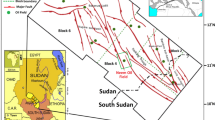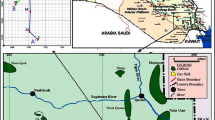Abstract
The present study aims to throw the light on the importance of the conventional and special core analyses in the integration with the petrographical studies for the formation evaluation of the reservoir rocks. The petrographical studies include the microfacies analysis and studying the diagenetic factors that predominated during the diagenetic history of the Belayim rock sequence in the study area. Two zones of Belayim Formation in the onshore Belayim oil field (the upper level (zone IIA) represents Hammam Faraun member and the lower one (zone IV) represents Sidri member) were studied. The measured routine core analyses data includes porosity (helium and summation fluids), density (grain and bulk), permeability (horizontal and vertical) and fluid saturations (oil and water). In addition, the formation resistivity factor, irreducible water saturation, Archie’s parameters (a, m and n), liquid permeability, relative permeability, wettability, the pore throat distribution, as well as the porosity and permeability measured under high pressure were measured as a special core analyses procedure. From the integration of the aforementioned petrographical and petrophysical studies, the Belayim Formation can be discriminated into three petrophysical facies (Facies-1, Facies-2 and Facies-3) described petrographically as (1) Facies-1 (argillaceous subfeldspathic arenite microfacies), (2) Facies-2 (siliceous quartz arenite microfacies) and (3) Facies-3 (dolomitic sublithic arenite microfacies). The petrophysical Facies-2 (siliceous microfacies) is characterized by the best reservoir properties (rank III, very good average porosity, very good permeability, fair to very good reservoir quality index (RQI) and relatively poor to good flow zone indicator (FZI), neutral to moderately oil wet and more than 75% macropores and mesopores). On the other side, samples of the petrophysical Facies-1 (argillaceous microfacies) have the lowest reservoir potential (rank VI, poor average porosity, poor to fair permeability, poor to impervious RQI and relatively poor to fair FZI and more than 50% micropores and nanopores). Therefore, it is recommended to use the conventional and special core analyses data in the integration with the petrographical studies as a good procedure for the formation evaluation and discrimination of the reservoir sequence into different flow units.



















Similar content being viewed by others
References
Al-Dhafeeri AM, Nasr-El-Din HA (2007) Characteristics of high permeability zones using core analysis, and production logging data. J Petrol Sci and Eng 55:18–36
AlSharhan AS, Salah MG (1994) Geology and hydrocarbon habitat in a rift setting: southern Gulf of Suez, Egypt
Amaefule JO, Altunbay M, Tiab D, Kersey DG, Keelan DK (1993) Enhanced reservoir description: using core and log data to identify hydraulic (flow) units and predict permeability in uncored intervals/wells. SPE 26436. Presented at the Annual Technical Conference and Exhibition, Houston, TX, pp 3–6
Archie GE (1942) The electric resistivity logs as an aid in determining some reservoir characteristics. Trans Am Int Mech Eng 146:54–62
Bosworth W, Crevello P, Winn RD Jr, Steinmetz J (1998) Structure, sedimentation, and basin dynamics during rifting of the Gulf of Suez and northwestern Red Sea. In: Purser BH, Bosence DWJ (eds) Sedimentation and tectonics of rift basins: Red Sea-Gulf of Aden. Chapman and Hall, London, pp. 77–96
Choquette PW, Pray LC (1970) Geologic nomenclature and classification of porosity in sedimentary carbonates. AAPG Bull 54:207–220
Darwish M, El-Araby AM (1993) Petrography and diagenetic aspects of some siliciclastic hydrocarbon reservoirs in relation to the rifting of the Gulf of Suez. Egypt J Geol 3:1–25
EGPC ‘Egyptian Geological Petroleum Corporation’ (1964) Miocene rock stratigraphy of the Gulf of Suez, Egypt. Internal Report p 412. Cairo
El Sharawy MS, Nabawy BS (2016) Geological and petrophysical characterization of the Lower Senonian Matulla Formation in Southern and Central Gulf of Suez, Egypt. Arab J Sci Eng 41(1):281–300
El-Gezeery MV, Marzouk IM (1974) Miocene rock stratigraphy of Egypt. J Egypt Geol Soc 18(1):1–59
El-Khadragy AA, Eysa EA, Khedr FI, Saleh AH (2016) Reservoir characteristics of Belayim Formation in Belayim land oil field, Southwest Sinai, Egypt, using core and well logging analysis. International Journal of Scientific Engineering and Applied Science (IJSEAS) 2(1):435–450
Gawad WA, Gaafar I, Sabour AA (1986) Miocene stratigraphic nomenclature in the Gulf of Suez region. In: Egyptian General Petroleum Corporation, 8th Exploration Conference, pp 1–20
Hughes GW, Abdine S, Girgis MH (1992) Miocene biofacies development and geological history of the Gulf of Suez, Egypt. Mar Pet Geol 9:2–28
Jarrige JJ, Ott d'Estevou P, Burollet PF, Montenat C, Richert JP, Thiriet JP (1990) The multistage tectonic evolution of the Gulf of Suez and northern Red Sea continental rift from field observations. Tectonics 9:441–465
Kassab MA, Teama MA, Cheadle BA, El-Din ES, Mohamed IF, Mesbah MA (2015) Reservoir characterization of the Lower Abu Madi Formation using core analysis data: El-Wastani gas field. Egypt J Afr Earth Sci 110:116–130
Levorsen AI (1967) Geology of Petroleum. W.H. Freeman Company, San Francisco, USA
Meshref WM, Abu Karamat MS, Gindi M (1988) Exploration concepts for oil in the Gulf of Suez. In: 9th Petroleum Exploration and Production Conference, Cairo, 1–24
Montenat C, Ott d'Estevou P, Jarrige JJ, Richert JP (1998) Rift development in the Gulf of Suez and the north-western Red Sea: structural aspects and related sedimentary processes. In: Purser BH, Bosence DWJ (eds) Sedimentation and tectonics of rift basins: Red Sea-Gulf of Aden. Chapman and Hall, London, pp. 97–116
Nabawy BS (2015) Impacts of the pore- and petro-fabrics on porosity exponent and lithology factor of Archie’s equation for carbonate rocks. J Afr Earth Sci 108:101–114
Nabawy BS, El Sharawy MS (2015) Hydrocarbon potential, structural setting and depositional environments of Hammam Faraun Member of the Belayim Formation, Southern Gulf of Suez, Egypt. J Afr Earth Sci 112:93–110
Nabawy BS, El-Hariri TY (2008) Electric fabric of subsurface Cretaceous rocks, Abu Gharadig Basin, Western Desert Egypt. J Afr Earth Sci 52(1–2):55–61
Nabawy BS, Géraud Y, Rochette P, Nicolas B (2009a) Pore-throat characterization in highly porous and permeable sandstones. AAPG Bull 93(6):719–739
Nabawy BS, Rochette P, Géraud Y (2009b) Petrophysical and magnetic pore network anisotropy of some cretaceous sandstone from Tushka Basin, Egypt. Geophys J Int 177(1):43–61
Othman A, Nabawy BS, Abdel Hafeez T, Saher M, Abdel KR (2008) Reservoir quality discrimination of the lower part of Bahariya Formation, N. Qarun Oil Field, W.D. Egypt. EGS J 6(1):81–101
Pettijohn FJ, Potter PE, Siever R (1972) Sand and sandstone. Chapter 4, Petrographic Classification and Glossary, pp. 149–174, Springer, New York.
Ramadan FS, Eysa EA (2012) Diagenesis and petrophysical properties of the Middle Miocene (Belayim Formation) at Belayim Land Oil Field, West Sinai, Egypt. Aust J Basic Appl Sci 6(6):309–322
Ramzy M, Steer B, Abu-Shadi F, Schlorholtz M, Mika J, Dolson J, Zinger M (1996) Gulf of Suez basin sequence models e part B. Miocene sequence stratigraphy and exploration significance in the central and the southern Gulf of Suez. In: EGPC 13th Exploration Conference, Cairo, Egypt, vol. 2, pp 242–256
Rashed A (1990) The main fault trends in the Gulf of Suez and their role in oil entrapment. In: 10th Petroleum Exploration and Production Conference, Cairo, pp 1–24
Scott RW, Govean FM (1985) Early depositional history of a rift basin: Miocene in the western Sinai. Palaeogeogr Palaeoclimatol Palaeoecol 52:143–158
Serra O (1988) Fundamentals of well-log interpretation: the acquisition of logging data, Chapter 1, pp. 1–24, 3rd edn. Elsevier, Amsterdam
Tiab D, Donaldson EC (1996) Petrophysics, theory and practice of measuring reservoir rock and fluid transport properties. Gulf Publ. Co., Houston, pp 205–220
Acknowledgements
The authors would like to acknowledge the Egyptian General Petroleum Corporation (EGPC) and Belayim Petroleum Company (Petrobel) for releasing the conventional and special core analyses data and licence the data processing and interpretation. The authors would like also to express their deepest acknowledge to the editor-in-chief for his great effort in editing the manuscript. Thanks are also due to the reviewers for their valuable corrections, suggestions and modifications that greatly enhanced the manuscript. Eventually, the Science and Technology Development Fund (STDF) of Egypt has to be acknowledged for introducing the fund of the present study through project number 4097.
Author information
Authors and Affiliations
Corresponding author
Additional information
This article is part of the Topical Collection on Current Advances in Geology of North Africa
Rights and permissions
About this article
Cite this article
Nabawy, B.S., Barakat, M.K. Formation evaluation using conventional and special core analyses: Belayim Formation as a case study, Gulf of Suez, Egypt. Arab J Geosci 10, 25 (2017). https://doi.org/10.1007/s12517-016-2796-9
Received:
Accepted:
Published:
DOI: https://doi.org/10.1007/s12517-016-2796-9




